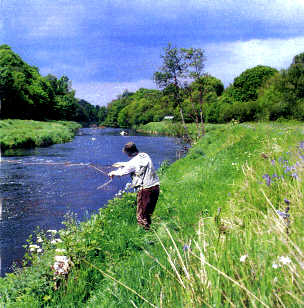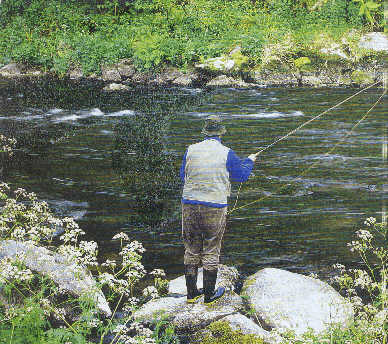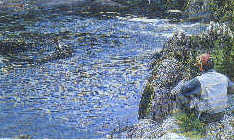| Introduction | Fishing Guide | Beat Map | Fishing Journal | Flies | Prices | Contact |
A Day In Spring,
When The Olives Hatch Again
from Country Illustrated April 1998
Fresh winds blowing under open skies, and Paul Sheehan feels a new year begin for trout-fishers. Time,for the quick-wristed art of wet-fly down on good Irish water ...
Photo below shows Ballin Temple beat with tea hut in the background.

Mid-April, and the lowland reaches of rain-fed rivers such as the Slaney come Into play. Fly life is richer here, the water is deeper, and the trout are bigger, though not so fat as those of the limestone streams.
In winter a river can look a sad place; even clear limestone waters, so promising with summer growth and life, show merely blank depths. This condition persists in my local rivers into early spring. Often, fishing for salmon from the end of February on, I have worked through long days without sight of fly, or of the trout which I know to be there.
But there comes a day in March, usually a day of open skies and fresh winds, when at about noon the first dark olive of spring appears. Having seen one, you gradually notice a procession of them, drifting and whirling down the grey currents. The trout are quick to move to them. Now that the apparently barren river is yielding its first crop of ephemerids, you see other signs of life. As you walk along the bank, if your river is in any wav clear, you see trout up in the water mid on the fin. The world is suddenly full of promise. The trout angler's year has begun.
This is my cue to turn out the assorted clutter of my fishing bag and put together the few bits of tackle necessary to enjoy the age-old simplicities of wet-fly fishing. This is the appropriate way to start the season because none of the modern distractions come between you and the fishing. You need none of the impediments which now afflict the angler. Neither do you need acquired skills or long training; nor the guidance of experts to enjoy to the full a day with a rod, line and a few standard flies under the broad swept skies of a fresh spring day.
Most of us in Ireland have access to a river which holds trout, be it a large stream or a brook. My rivers are either rain-fed, flowing from rock which gives a soft water but poor nutrition to their many trout, or they are limestone streams with rich feeding and much bigger fish. But in either type it is too early to be fishing the dry fly in March or early April. There is not quite enough surface activity. Once you have seen that first hatch of olives, you know the fly are there, and that the watchful trout know it too. Even though the quiet surface will reveal none of this for much of the day, you may be confident of good sport with flies fished just under it.
A lissome old 10 ft rod with a nice balance and a slim profile allows me, when my hand is in, to flick out line in the busy but graceful style of the practised wet-fly fisher. One of the deepest pleasures of angling, as Skues noted, is the satisfactory performance of function. And that function in wet-fly fishing is a fluent combination of things, the management of the line, the delicacy of the cast, the alertness to a take, the selection of the next stream, all knit together by your total absorption in the task. When you have finished fishing a stream and look back, you see that the process has taken you two hundred yards downstream from where you started, and engaged your concentration wholly all the way, in a manner at once alert and deeply relaxing.
The very simplest of wet-fly dressings are appropriate. I like the range of patterns collectively known as spiders, and developed in the English north country, the Borders and the Scottish lowlands. Snipe and Purple, Partridge and Orange, and Waterhen Bloa are the basis of a fly box for a day's wet-fly fishing in spring, and in fact on most days would be more than sufficient if carried in sizes 12 to 16. I fish only two wet flies on a 10 foot leader of 3 pounds test. In the past, a cast of three flies was the norm and some fished as many as six. But 1 find my duo enough, and I am satisfied that each is fishing in the most promising planes of the water; that is, just in the surface and just under it.
My first outings are to the upper reaches of rain-fed rivers. The upper Liffey, above Manor Kilbride, is a true upland stream, cutting through moor and bog and fed by innumerable small tributaries. It is an ideal medium for the wet fly. Pick a day in late March or early April with a promise of sunshine, and threats of showers and a fresh westerly. In other words, a day which spring often still provides, despite the apparent changes in our climate. It is the kind of day for a heavy jumper, a good waterproof and an urge to be on the move, for if you linger in these exposed tops the wind will chill you through. The river is stony and shallow and all of it can be fished from the bank, so a good pair of walking boots will give comfort and a good purchase when the going is rough.

County Waterford and the Slaney again, where spring starts early; wet-fly is still the method of choice.
A Partridge and Orange is secured to the point, and a Greenwell Spider to the dropper, 4 ft up the leader. Sufficient fly-line is pulled off to allow the leader and only the leader to settle in the water; this length will vary depending on the breeze and its direction, but in any case should never be very long. Cast at 45 degrees downstream, let the line wash round, take a step and flick it out again, and soon there will be a pluck, then with any luck a firm pull and a fish of seven or eight inches will come to hand.
If they are in the mood you may get a take every other cast, ray and a fish every half dozen, and most of them will be between six and nine inches long. On a good day you may get a 12-inch trout. Then you must decide whether to fish on and possibly tarnish this triumph, because you will not catch a better one.
I fish on, because the trout are incidents, essential incidents, of the experience. This fishing does not have the climatic cycles of dry-fly fishing for huge trout during mayfly time, or of swimming a fly over a known salmon lie with blood pounding in your ears. Early spring trout fishing is a blend of simple satisfaction, some intrinsic to the craft, some absorbed from being abroad in the crisp air, seeing the harbingers of new growth.
A little later, about mid-April, hatches of fly on lowland reaches of rain-fed rivers such as the Slaney have become reliable enough to deserve attention. The fish here are bigger, though still not the fat stock of the limestone streams. The fly life is also somewhat richer, and the water deeper. The wet fly is still the method of choice but it needs to be adapted. The same tackle will do, and if the fish are active in the rocky shallow reaches, the same method of a short line fished downstream works well.
But often the fly hatch out in water 4 or 5 ft deep with a smooth surface. Wet-fly down will not do very well there. What is needed for sport is a combination of favourable conditions and a specific tactic. The conditions are provided by an upstream breeze, strong enough to move the smaller branches of trees, driving flock cloud before it; the kind of day where the shadows of clouds drift across the uplands. You need to choose a stretch of river where the current sets against the near bank. The hatching fly will ride down this and trout will soon take up station and be accessible to a fly cast on a short line upstream.
These are slightly less reckless fish than the hungry hordes of the moorland headwaters. They can afford to pick and choose, and they are very particular about flies coming to them out of the loom of a big bankside shadow upstream. So the angler still fishes as short a line as he can manage, but upstream and over trout which have started rising to hatching fly. The cast is made, the flies drift down, and the line hand gathers in the loose coils while the rod is raised to ease back the flies just a shade faster than the current speed. You may feel a fish at the flies, but you also have to look out for more subtle signs of interference-a flash in the water, a pull or stop on the leader-to flick home the hook.

The Sheen River at Kenmare, Co Kerry, flows in steep, gushing streams between pools cupped in rock.
A good angler may pass two hours of an April noon fishing down a few hundred yards of water in this way, perhaps landing a dozen trout, firm, bright fish up to half a pound or even three-quarters of a pound. This is sport to relish, and is utterly spoiled if you bring to it inappropriate expectations. A bag of native brown trout, small though they may be, is reward enough on a good spring day, the day where you may practice anew the foundation skills of the flyfisher, for surely all flyfishing goes back to this simplicity. Modern angling can be, to an extent has been, corrupted by the values of the stockpond. Spring trout fishing remains a touchstone where the trout angler experiences again the things which first made fishermen of us-solitude, the beauty of the small, jewelled trout, the sympathy with landscape and season.